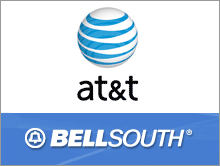|
Forget Ma Bell, think Ma Cell AT&T's $81 billion BellSouth deal is all about wireless. When it happens, the world of big-business telecom sales will never be the same.
(Business 2.0 Magazine) -- AT&T's bid to acquire BellSouth has run into a few snags lately, but make no mistake: The $81 billion deal will happen - and when it does, the impact will be far bigger on corporate America than on consumers. This deal isn't about a return to Ma Bell, the telephone monolith that was famously broken up two decades ago. It's about Ma Cell and the future of wireless communication for businesses.
Both AT&T (Charts) and BellSouth (Charts) have been key players in the $100 billion market for big-business telecom services. Together they just might be unstoppable. The future of connectivity How so? Because consolidating control over their Cingular Wireless joint venture will transform the mobile operator into a far more nimble competitor. But there's another reason: a new technology known as IMS. It promises to cure the perennial IT headache of making sure that employees stay connected and productive on the go. With IMS technology, CIOs won't have to think about equipping employees with landlines and e-mail pagers and calling cards and cell phones and laptop network cards. They'll just buy connectivity, plain and simple. Both Cingular and AT&T separately have invested heavily in IMS. "IMS is where the industry is headed," says John Byrne, an analyst with Technology Business Research. "It makes perfect sense for [those parallel efforts] to be integrated."' An AT&T spokesman declined comment for this story, citing the pending merger. The deal's expected Federal Communications Commission approval last week has been held up by last-minute conditions sought by some regulators. But AT&T's past statements, analysts, and industry sources paint a clear picture of what's ahead for the combined company and its corporate customers. Hanging up on separate networks To be sure, IMS won't alleviate any IT migraines anytime soon. The technology is somewhat complex: it promises to seamlessly route voice and data over any network whether it's wired, wireless, 3G or Wi-Fi. Ultimately the information will travel over the same secure backbone. But Byrne, for one, thinks it will take a few years before engineers work out all of the kinks. IMS is just one factor driving the AT&T-BellSouth merger. The other is the advantage of having their currently separate wired and wireless phone networks under one roof. Full control over a cellular network will enable AT&T to offer and sell services far more quickly than when Cingular was a joint venture - and subject to the inevitable limits of two competitors trying to work together. Take AT&T's pending rollout of a citywide Wi-Fi network in Riverside, Calif. Before the merger deal, a project like this could be seen as competing with Cingular's 3G network and the partners could easily have squabbled over it. Now AT&T can freely sell customers access to either its 3G network or Wi-Fi hotspots - or both. Indeed, expect to see AT&T selling business customers combination phones that work on Cingular's cellular network, over corporate Wi-Fi networks, and at AT&T-managed Wi-Fi hotspots. It's a key advantage. AT&T archrival Verizon (Charts), which owns 55 percent of Verizon Wireless, doesn't have that freedom. It still has to dicker with Verizon Wireless joint venture partner, U.K.-based Vodafone (Charts), over who gets paid for what. Rebirth of a salesman AT&T will also have another advantage - its large corporate salesforce that's used to cultivating Fortune 500 customers and selling packaged deals. These salespeople have had to operate at arm's length with Cingular, bringing in a Cingular representative to sell a deal that includes wireless services. After it takes control of Cingular, AT&T salespeople will be able to sell wireless directly to their existing accounts. "The fact that you even have to ask who owns the account points out why it makes sense for the Cingular venture to go away and be brought into AT&T," says Byrne. And it's not just Cingular as a corporate entity that's set to disappear: AT&T has said that the Cingular brand itself will fade away. Some consumers may miss the Cingular brand, which seemed younger and hipper than AT&T. But for corporate customers, the seriousness and solidity of the AT&T brand is more reassuring. Who needs Cingular? And as technological change makes the distinction between wired and wireless connections less meaningful, it's not clear what value a separate wireless brand would have in a few years anyway. So goodbye and good riddance, Cingular. Getting rid of the separate wireless brand - and separate wireless technology - is a great example of the simplicity that the newly expanded AT&T promises. Here comes Ma Cell: A network that's everywhere, and that you don't have to think about. Ubiquity and stability. When you think about it, that doesn't sound that different from the Ma Bell of old. |
|

